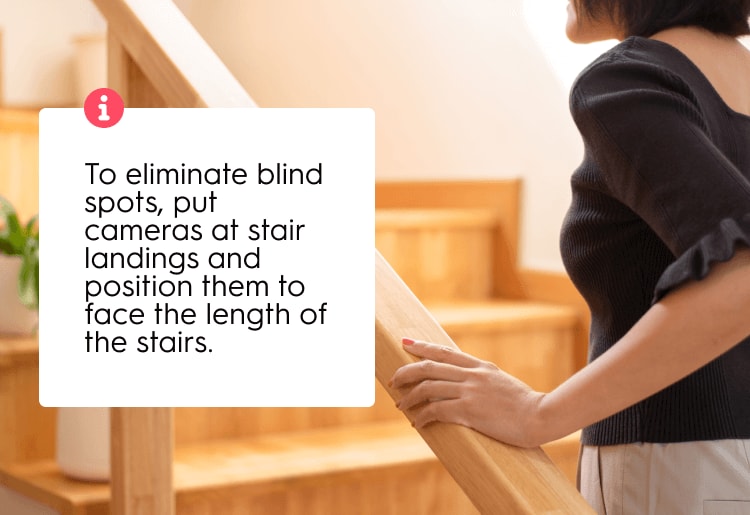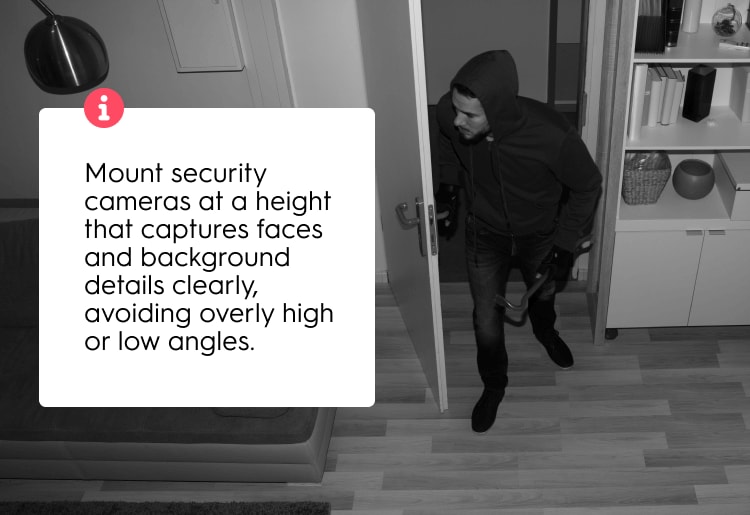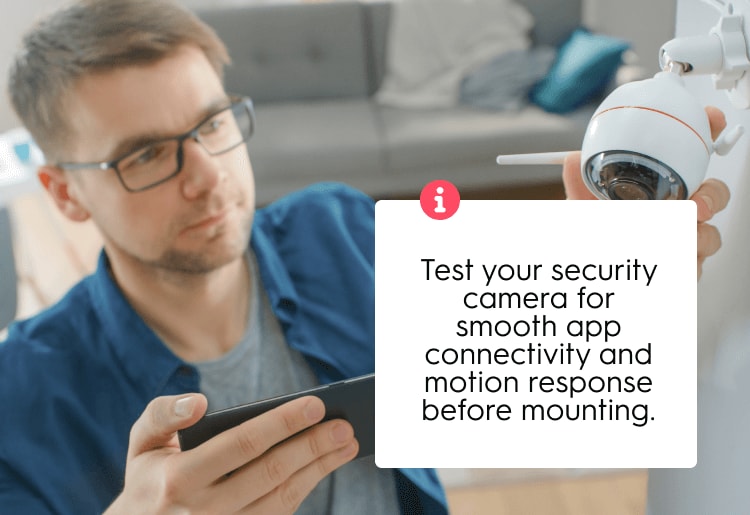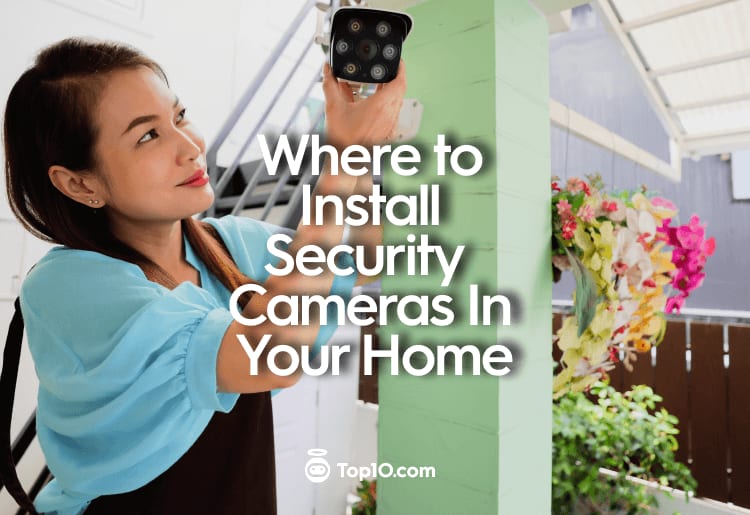When it comes to home security systems, I always tell my customers that cameras should be priority number one. With property crimes making up 16% percent of burglaries, full coverage is a must.
In the past 20+ years as a specialist in the industry, I've learned the best angles for monitoring entry points, eliminating blind spots, and keeping watch over valuables. I aim to give you peace of mind while capturing crystal-clear footage if an unfortunate event occurs.
Choosing the Right Cameras
Specific providers like Vivint and ADT offer AI-driven security with remote access and 24/7 monitoring. Frontpoint Security is a fantastic option if you're on a tight budget and prefer easy DIY installation.
Use a mix of discreet and visible cameras for optimal coverage. Low-profile, small cameras like those from Cove are easy to position and install—even for beginners.
Should I Get Security Cameras Installed Professionally?
Consider what will work best for your needs and budget. Most cameras simplify DIY installation—just follow the instructions on the relevant websites or apps. However, some home security companies like ADT and Vivint require professional installation.
If tackling a full wiring and setup process sounds daunting, services like SimpliSafe or Abode allow you to set up your cameras with third-party technicians. Do some research to understand what's involved.
Where to Install Security Cameras
Front Door
Place a security camera facing your front door at eye level to see visitors and monitor deliveries. With package theft impacting 26% of people, you’ll want multiple angles to avoid blind spots.
A video doorbell doubles your visibility. You'll see visitors from your phone wherever you are. You can also talk to people at your front door with two-way audio. Vivint's smart doorbell alerts you when a package gets delivered to combat porch pirates. You'll keep your entryway secure with clear facial shots and expanded coverage.
Back Door
Your back door is another access point for intruders, so secure it with a mounted camera aimed downward. Position it above the door to capture a wide view and clear shot of anyone passing through. Make sure you monitor the surrounding area as well.
To keep watch 24/7, install an infrared night vision cam. Deep Sentinel's cameras let you observe activity in total darkness, with a broad perspective of your entry and exit both day and night.
Garage
Your garage is full of big-ticket items like cars and tools that thieves love to swipe. Put cameras inside to watch over your gear and catch any unwanted visitors. Outside, point them at the garage doors to spot criminal activity and mount them up high so they can't be tampered with.

Windows
Learning how to secure your windows is essential—they're easy access points for break-ins. Put cameras on any first-floor or basement windows. Aim them at the window itself and the area around it. This lets you spot any sketchy activity or objects right away. Consider adding extra monitoring on windows that aren't visible from the street.
Living Spaces
For living spaces, like lounges and recreational rooms, use discreet wide-angle cameras to watch over things without intruding on privacy. Cove has motion-activated cams that differentiate between humans and pets so you don't get unnecessary alerts. Position them to steer clear of filming private spots like bathrooms.
Hallways
For maximum coverage, put surveillance at the end of your hallways. Add extra cameras at hall intersections or blind spots and tilt them to avoid aiming at windows or lights head-on. You can try ADT Self Setup options to protect these points.
Staircases
To eliminate blind spots, put cameras at stair landings and position them to face the length of the stairs. Low-light options work best with the inconsistent lighting you sometimes get in stairwells. Outside stairs need cameras, too, so pop one at the top and bottom to watch who's coming and going.

Perimeter
You've likely heard of some bizarre security camera footage. Protect your property by focusing on fences, yards, driveways, and exterior walls. This complete coverage lets you catch intruders quickly. Choose long-range, wide-angle outdoor security cams for large areas. Position them with clear lines of sight, moving obstructions like plants or decor out of the way.
Outbuildings
Know the signs your home is being targeted. Install security cameras on detached buildings, garages, and sheds, as their isolation attracts thieves. Strategically mount structures for close-up views.
Have additional cameras monitoring the surrounding zone from different angles for overlapping visibility. This layered security in vulnerable areas will deter and catch would-be intruders.
High-Value Rooms
Rooms with high-value items like jewelry, art, or cash require extra security. Install discreet cameras that cover entryways and overlapping zones inside. Avoid filming private storage spaces or safes. Consider SimpliSafe motion sensors, which signal cameras to start recording only when necessary.
Blind Spots
Take a moment to inspect your property for areas hidden from your cameras' view, like alcoves, short corridors, overgrown landscaping, or stairwells. Then, get creative about positioning security cameras or motion-activated lighting to enhance visibility. And if you renovate, remember to identify any new blind spots.
» Check out these expert tips for installing discreet home security cameras.
Other Considerations For Installing Security Cameras
Take Note of Camera Positions and Angles
When positioning security cameras, mount them at a height that captures facial details for identification and relevant background details. Avoid angles that are too high or low.
Here are some additional tips for optimal camera angles:
- Mount it at eye level—about 5-6 feet from the ground—to see facial features clearly.
- Tilt cameras around 10-15 degrees downwards to include a subject's face and upper body rather than just their scalp.
- Adjust pan angles to cover an entire entryway or room, minimizing the need for multiple models.
- When covering staircases, position the camera to see ascending and descending subjects.
Avoid Reflection and Glare
Avoid positioning cameras where they point directly into light sources, creating glare and rendering footage unusable. Face them away from direct light sources like lamps, windows, and reflections, which can overexpose footage.
Consider the Durability of Security Cameras
When choosing outdoor options, consider the weather conditions they'll face. Opt for models with wide temperature ranges and high IP ratings, like Scout Alarm's HD camera, to withstand the elements. Mount uncovered cameras under eaves or covers to protect the lens from rain and snow.
Test Your Cameras
Before you mount your security camera, test it to ensure it connects smoothly to your security app. Try a few motion tests to see if you're experiencing any lag. If you encounter any problems, contact your provider or get a replacement.

Prioritize Lighting When You Install Security Cameras
Cameras can deter crime, and they perform best in consistent, moderately bright lighting. Here are some more tips to ensure your footage gets the illumination it needs:
- Test the visibility day and night. Add lighting if needed for clear images.
- Avoid aiming them at bright light sources to prevent glare and overexposure.
- Install motion-activated security lights to illuminate areas at night.
- Use overhangs or covers to reduce sunlight glare.
- Install shading, blinds, or filters in rooms with harsh contrasts of light and shadow.
- Select options with infrared, low-light, or night vision capabilities.
- Choose cameras with wide dynamic range (WDR) to handle high-contrast lighting.
- Add strategic floodlights, spotlights, or pathway marker lights to reduce shadows.
- Keep the lenses and external lighting clean and well-maintained for optimal visibility.
- Use a consistent lighting style throughout for easier integration and maintenance.
Laws on Where to Place Security Cameras
Consider installing home surveillance if you live in a state with high burglary rates. However, be aware of privacy laws regarding security cameras in the US. Generally, recording video in public places is legally permissible. Still, areas where people expect reasonable privacy, like bathrooms or changing rooms, are off-limits.
Audio recording laws can be more complex, with some states requiring all parties to consent. Keep your neighbors' right to privacy in mind as you take steps to improve your security.
Achieving safety in your own home shouldn't cost someone else's comfort. You can consult resources like the Electronic Privacy Information Center (EPIC) for more detailed information.

Optimize Your Home Security
When I looked into home security systems to protect my family, I learned a lot about strategic camera placement. Like these ADT alternatives, robust home security relies on monitoring entry points, weak spots, and our most prized possessions.
I'd recommend working with professionals to customize solutions for your unique home layout legally. Following best practices and ensuring proper lighting can go a long way in boosting safety while still respecting privacy.
» Find out how to choose the best home security system.

